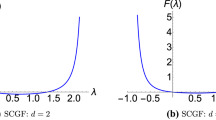Abstract
This paper presents how a non-commutative version of the entropy extremalization principle allows to construct new quantum hydrodynamic models. Our starting point is the moment method, which consists in integrating the quantum Liouville equation with respect to momentum p against a given vector of monomials of p. Like in the classical case, the so-obtained moment system is not closed. Inspired from Levermore's procedure in the classical case,(26) we propose to close the moment system by a quantum (Wigner) distribution function which minimizes the entropy subject to the constraint that its moments are given. In contrast to the classical case, the quantum entropy is defined globally (and not locally) as the trace of an operator. Therefore, the relation between the moments and the Lagrange multipliers of the constrained entropy minimization problem becomes nonlocal and the resulting moment system involves nonlocal operators (instead of purely local ones in the classical case). In the present paper, we discuss some practical aspects and consequences of this nonlocal feature.
Similar content being viewed by others
REFERENCES
P. Andriès, P. Le Tallec, J. P. Perlat, and B. Perthame, The Gaussian-BGK model of Boltzmann equation with small Prandtl number, preprint.
P. Argyres, Quantum kinetic equations for electrons in high electric and phonon fields, Phys. Lett. A 171:373-379 (1992).
A. Arnold, J. Lopèz, P. Markowich, and J. Soler, An analysis of quantum Fokker-Planck models: A Wigner function approach, preprint (2002).
R. Balian, From Microphysics to Macrophysics (Springer, 1982).
J. Barker and D. Ferry, Phys. Rev. Lett. 42(1997).
A. Caldeira and A Leggett, A path integral approach to quantum Brownian motion, Phys. A 121:587-616 (1983).
P. Degond, Mathematical Modelling of Microelectronics Semiconductor Devices, Proceedings of the Morningside Mathematical Center, Beijing (AMS/IP Studies in Advanced Mathematics, AMS Society and International Press, 2000), pp. 77-109.
P. Degond, F. Méhats, and C. Ringhofer, On a quantum energy-transport model, in preparation.
P. Degond and C. Ringhofer, A note on quantum moment hydrodynamics and the entropy principle, C. R. Acad. Sci. Paris Sér. I Math. 335:967-972 (2002).
P. Degond and C. Ringhofer, A note on binary quantum collision operators conserving mass momentum and energy, submitted.
D. Ferry and H. Grubin, Modelling of quantum transport in semiconductor devices, Solid State Phys. 49:283-448 (1995).
F. Fromlet, P. Markowich, and C. Ringhofer, A Wigner function approach to phonon scattering, VLSI Design 9:339-350 (1999).
C. Gardner, The quantum hydrodynamic model for semiconductor devices, SIAM J. Appl. Math. 54:409-427 (1994).
C. Gardner and C. Ringhofer, The smooth quantum potential for the hydrodynamic model, Phys. Rev. E 53:157-167 (1996).
C. Gardner and C. Ringhofer, The Chapman-Enskog expansion and the quantum hydrodynamic model for semiconductor devices, VLSI Design 10:415-435 (2000).
I. Gasser and A. Jüngel, The quantum hydrodynamic model for semiconductors in thermal equilibrium, Z. Angew. Math. Phys. 48:45-59 (1997).
I. Gasser and P. A. Markowich, Quantum hydrodynamics, Wigner transforms, and the classical limit, Asymptot. Anal. 14:97-116 (1997).
I. Gasser, P. Markowich, and C. Ringhofer, Closure conditions for classical and quantum moment hierarchies in the small temperature limit, Transport Theory Statist. Phys. 25:409-423 (1996).
H. Grad, On the kinetic theory of rarefied gases, Comm. Pure Appl. Math. 2:331-407 (1949).
H. Grubin and J. Krekovski, Quantum moment balance equations and resonant tunneling structures, Solid State Electron. 32:1071-1075 (1989).
B. Hellfer and J. Sjöstrand, Equation de Harper, Lecture Notes in Physics, Vol. 345 (Springer, 1989), pp. 118-197.
S. Jin and X. T. Li, Multi-phase computations of the semiclassical limit of the Schrödinger equation and related problems: Whitham vs. Wigner, preprint, University of Wisconsin (http://www.math.wisc.edu/∼jin/publications.html).
A. Jüngel and P. Pietra, A discretization scheme for a quasi-hydrodynamic semiconductor model, Math. Models Methods Appl. Sci. 7:935-955 (1997).
M. Junk, Domain of definition of Levermore's five-moment system, J. Stat. Phys. 93:1143-1167 (1998).
M. Junk, Maximum entropy for reduced moment problems, Math. Models Methods Appl. Sci. 10:1001-1025 (2000).
C. D. Levermore, Moment closure hierarchies for kinetic theories, J. Stat. Phys. 83:1021-1065 (1996).
R. Luzzi, Untitled, electronic preprint archive, reference arXiv:cond-mat/9909160 v2 11, September 1999.
V. G. Morozov and G. Röpke, Zubarev's method of a nonequilibrium statistical operator and some challenges in the theory of irreversible processes, Condensed Matter Physics 1:673-686 (1998).
I. Muller and T. Ruggeri, Rational Extended Thermodynamics, Springer Tracts in Natural Philosophy, Vol. 37, 2nd ed. (Springer, New York, 1998).
F. Nier, A variational formulation of Schrödinger-Poisson systems in dimension d≤3, Comm. Partial Differential Equations 18:1125-1147 (1993).
M. Reed and B. Simon, Methods of Modern Mathematical Physics. Vol. 1: Functional Analysis (Academic Press, 1980).
J. Schneider, Entropic Approximation in Kinetic Theory, preprint, Analyse non linéaire appliquée et modélisation, Université de Toulon et du Var, BP 132, 83957 La Garde cedex, France (2001).
D. Serre, Systèmes de lois de conservation, Tome I et II (Diderot, Paris, 1996).
M. A. Shubin, Pseudodifferential Operators and Spectral Theory (Springer, 1980).
J. Smoller, Shock Waves and Reaction-Diffusion Equations, Grundlehren der mathematischen Wissenschaften, Vol. 258, 2nd ed. (Springer, New York, 1994).
D. N. Zubarev, V. G. Morozov, and G. Röpke, Statistical Mechanics of Nonequilibrium Processes, Vol. 1, Basic Concepts, Kinetic Theory (Akademie Verlag, Berlin, 1996).
Author information
Authors and Affiliations
Rights and permissions
About this article
Cite this article
Degond, P., Ringhofer, C. Quantum Moment Hydrodynamics and the Entropy Principle. Journal of Statistical Physics 112, 587–628 (2003). https://doi.org/10.1023/A:1023824008525
Issue Date:
DOI: https://doi.org/10.1023/A:1023824008525




